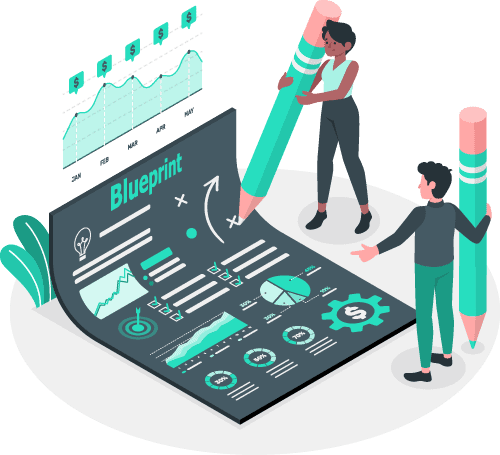You’re staring at your laptop on a Sunday afternoon, wondering if freelancing could be your ticket out of the 9-to-5 grind. Maybe you’ve got marketable skills collecting dust while you trade hours for a paycheck.
Or perhaps you’re comparing freelancing to YouTube channels, online courses, and dropshipping stores, trying to figure out which weekend business model won’t consume your life.
I’ve tested most online business models over the past decade, including freelancing. What I learned surprised me. Freelancing isn’t the passive income dream some gurus sell. It’s also not the entrepreneurial dead-end critics claim.
The real question isn’t whether freelancing is profitable. It’s whether freelancing right for your specific goals, constraints, and timeline. Let’s cut through the noise and figure out if freelancing is right for you.
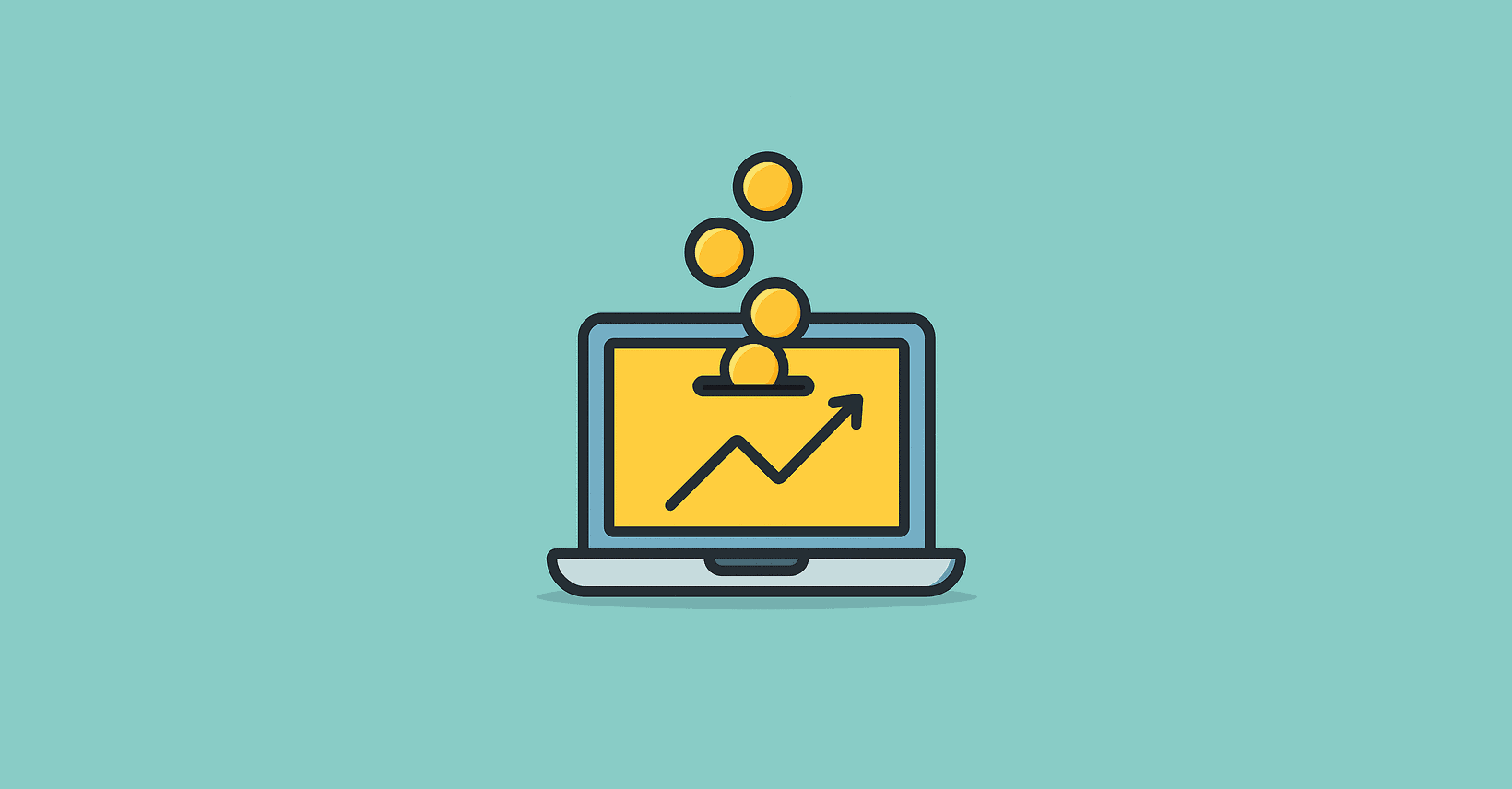
What Freelancing Means
Freelancing means trading your specialized skills for direct client payment on a per-project basis. You’re not building a product or growing an audience. Your expertise becomes the product, solving specific problems for paying clients right now.
Active income defines the model. Every dollar requires your direct involvement. Unlike a YouTube channel that generates ad revenue on old videos or a course that sells while you sleep, freelancing stops paying the moment you stop working.
Weekend freelancers earning $800-$5,000 monthly prove the model works for part-time solopreneurs, but they’re actively working for every dollar.
Full-time freelancers average 43 billable hours weekly with zero residual revenue. Going freelance full time means every dollar depends on active client work with zero residual revenue stream. This makes it worse than having a full-time day job.
When you finish a project, your income stream from that client ends. You’re back to finding the next client. Nothing about this is passive. You’re trading specialized hours for premium dollars.
The advantage? Marketable skills mean you can start freelancing today. No audience building required. No product development phase. You find clients, deliver work, get paid. That directness appeals to solopreneurs who need income within weeks, not years.
Look, I’m not trying to scare you off. I freelanced for two years as a side hustle, before admitting to myself it wasn’t building the business I wanted. But for some people? It’s perfect.
Is Freelancing Right for You?
Here’s the weird part: the freelancers who succeed long-term usually don’t love freelancing. They love what freelancing funds. Keep that in mind.
You need income immediately
You have marketable skills
Enjoy client work & quick feedback loop
You want revenue without trading hours
Hate income unpredictability
You struggle with self motivation
Here are some reasons why you would consider freelancing:
Freelancing pays fast: Need $2,000 to invest in course creation tools or paid ads for your blog? Freelancing gets you there in 30 to 60 days instead of 12 months. You can land your first client this weekend and invoice them next week. So if you need income in weeks, not months or years, then freelancing is right for you.
Marketable Skills: Freelancing lets you monetize existing capabilities right away instead of spending months learning a new business model. No need to build an audience or create inventory before your first dollar. Video editors, copywriters, and web designers start earning without product development.
Direct Client Work & Quick Feedback Loops: Freelancing suits people energized by helping clients solve specific problems directly. If you get satisfaction from delivering tangible results and receiving direct appreciation, freelancing feels more rewarding than building passive systems.
Freelancing fails dramatically for certain goals and personality types. If any of these situations describe you, consider other models instead.
Hate trading time for money: Freelancing caps earnings at your available hours x your hourly rate. If your goal is replacing your day job income and going freelance full time within 12 months, part time freelancing won’t get you there. The math doesn’t work.
Income Unpredictability: If financial unpredictability triggers anxiety or threatens your ability to meet obligations, freelancing will make you miserable. One month you invoice $5,000 and the next month you barely hit $1,200. Freelancing delivers feast or famine cycles, especially in your first year. Mortgage payments, childcare, and fixed expenses require consistent cash flow.
Struggle with Self-Motivation: No manager enforces deadlines or provides accountability for your weekend work sessions. If working on saturday mornings feel like a chore rather than an opportunity to build something, freelancing will destroy your weekends and your reputation without building your business.
Why New Freelancers Struggle
Starting a freelance business sounds liberating until you hit the realities that crush most beginners. Understanding what you’re walking into helps you prepare or pivot to a different model.
The freelancing life looks attractive from the outside. Set your own rates. Choose your clients. Work from anywhere. But the day-to-day reality involves challenges most beginners don’t anticipate until they’re already committed.
Client Acquisition Treadmill
I ran a content writing service on Fiverr for eight months in 2013. Every Saturday morning felt like starting from zero, even though I’d delivered 40+ projects. The momentum never compounded the way my blog traffic did.
I thought landing my first few freelance clients meant I’d built momentum. Wrong. Every completed project meant starting the client search from zero again.
There’s no compounding effect like content creation where old blog posts keep bringing traffic. Almost half of freelancers spend 6 hours on average on unproductive work including client acquisition and administrative tasks.
That’s 6 hours you’re not billing. That’s 6 hours you could spend creating a digital product that sells repeatedly.
Weekend constraints make this worse. Full-time freelancers can respond to inquiries within hours, nurture leads during the week, and jump on discovery calls.
You’re competing with people who have 40+ hours to hunt for clients while you’ve got 15 weekend hours. Every completed project means starting the search cycle again, and your limited availability puts you at a disadvantage.
Income Unpredictability
My worst month showed $280 income after three clients delayed payment simultaneously. My best month hit $4,100. Both happened within the same quarter. That volatility pushed me toward affiliate marketing and digital products where old work kept paying.
Freelancing feels profitable when you land a $3,000 project. Then the client takes 45 days to pay. Sometimes they don’t pay at all.
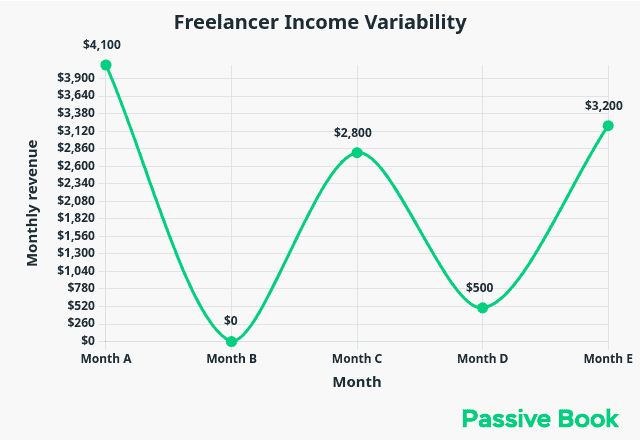
58% of freelancers globally encounter non-payment or delayed payments in 2025, threatening financial stability. Here’s what freelancers don’t tell you on Instagram: delayed payments wreck monthly budgets for over half of all freelancers.
Your monthly revenue swings wildly. One month you bill $4,000.
The next month, projects wrap up on day 29 and you show $0 income despite working all month. The impact goes beyond inconvenience. Delayed payments destroy financial planning for people with fixed obligations.
No income arrives during vacation, illness, or gaps between projects. Take a week off and your revenue stops completely. Get sick for two weeks and you’ve lost half the month’s potential income with no safety net.
AI Eroding Freelance Markets
The AI conversation around freelancing is more nuanced than “robots are taking our jobs.” By 2025, AI is expected to eliminate 85 million jobs but create 97 million new ones, resulting in a net gain of 12 million jobs globally.
The shift isn’t about elimination. It’s about transformation.
What’s really happening? Freelancers are being hired to humanize and refine AI-generated content, with editors reporting half their jobs come from rewriting AI articles. The work shifted from pure creation to strategic refinement.
Successful freelancers in 2025 use ChatGPT, Claude, and AI tools as productivity multipliers rather than competitors. They deliver faster, offer more iterations, and command premium rates for strategic thinking AI can’t replicate.
Commodity freelancers doing basic tasks got squeezed. Strategic freelancers combining AI with expertise are thriving.
Income & Profitability
Most freelancers brag about gross revenue and ignore what they keep. That $5,000 monthly income sounds impressive until you calculate your take-home. The real profitability equation reveals whether freelancing makes financial sense.
Gross revenue minus 25% for taxes, 20% on tools and platform fees. If you earned $2,000 this month, you’re not taking home $2,000. You’re paying $500 in taxes, potentially $300 in platform fees if you’re on Fiverr, and $100 for tools like Adobe Creative Cloud or Grammarly.
Most freelancers don’t calculate their effective hourly rate including unpaid hours. Unpaid hours for client acquisition, revisions, and administration reduce your effective hourly rate by 25 to 40%.
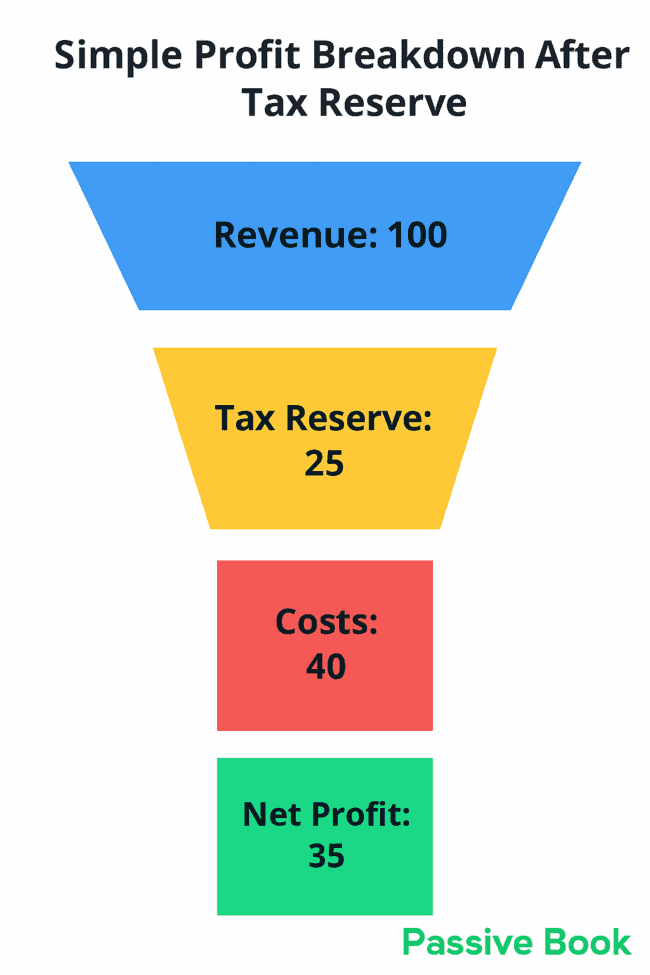
You spent 4 hours landing that client. You spent 2 hours on revisions outside the project scope. You spent 1 hour on invoicing and administrative tasks. Those 7 hours were unpaid but essential to earning the $2,000.
This math explains why many weekend freelancers quit after six months. The effective hourly rate doesn’t justify the hustle.
How Much do Freelancers Earn
Realistic targets for part time freelancers sit at $1,000 to $3,000 monthly with consistent 15 to 20 hours invested, with experienced weekend freelancers reaching $5,000 per month. These numbers assume you’ve got marketable skills and commit to consistent client acquisition efforts.
The freelancers earning $5,000 monthly on weekends didn’t start there. They spent 6 to 12 months building skills, reputation, and client relationships. They invested in their expertise and figured out which services commanded premium rates. Your first-year average will likely land between $1,500 and $2,500 monthly if you’re consistent.
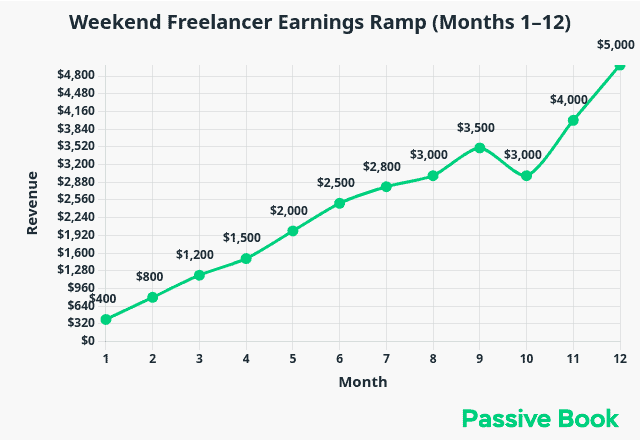
Hidden Costs
Most beginners focus on gross revenue and ignore the expenses eating 30-50% of earnings.
- Design tools (Adobe, Canva Pro): $20-$80/month
- Project management (Asana, Trello): $0-$20/month
- Communication (Zoom, Calendly): $0-$30/month
- Accounting (Wave, Freshbooks): $0-$25/month
- Total Monthly Tools: $50-$200
- Fiverr: 20% of every transaction
- Upwork: 10% on lifetime billings with each client
- Freelancer.com: 10% or $5 minimum per project
- Direct clients: 0% (but 2.9% + $0.30 for PayPal/Stripe)
Most freelancers underestimate taxes until owing thousands in April. Set aside 25-30% of gross revenue immediately. The IRS expects quarterly estimated payments: April 15, June 15, September 15, January 15
Best Skills for Part-Time Freelancers
Not all freelance services work on a part-time schedule. Client-facing work requiring weekday meetings fails right away. So building a successful freelance business part time requires choosing services that don’t penalize your limited availability.
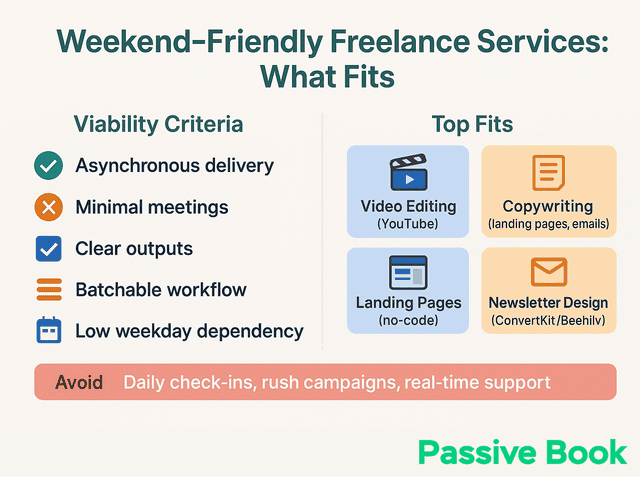
Copywriting, social media management, and data analysis are among the highest-demand beginner-friendly freelance skills in 2025. These services share common characteristics. They’re deliverable on your schedule. They don’t require you to be available during business hours. They produce concrete outputs clients can review asynchronously.
Avoid graphic design for fast-turnaround marketing campaigns or virtual assistant work requiring daily check-ins. Prioritize projects where you can batch work into focused weekend sessions and deliver completed work Monday morning.
Video Editing for YouTube Creators: YouTube creators drowning in 4-hour raw footage files need consistent editing but don’t care when you do the work. You edit long-form YouTube videos and create 30+ short-form clips monthly. This work is pure heads-down editing without meetings.
Copywriting for Small Business Marketing: Established freelance copywriters earn $500 to $2,000 per project writing persuasive sales pages, email sequences, and website copy. Even beginners landing their first 5 clients can expect $200-$400 per project. Writing happens entirely on your schedule. Clients send you their offer details and target audience information. You write the copy as per your schedule.
Landing Page Design Using No-Code Tools: Building conversion-focused pages using Webflow or Wix doesn’t require coding knowledge. Freelance no-code designers using Framer and Webflow charge $17 to $80 per hour for web design projects without coding skills. Project-based pricing works better for part-time freelancers. Charge $800-$2,500 per landing page depending on complexity. Complete 2-3 pages monthly for $2,000-$6,000 income on weekend hours alone. Small businesses need landing pages for product launches, lead magnets, and sales campaigns.
Email Newsletter Design for Creator Businesses: Content creators and solopreneurs building email lists need weekly newsletter design and formatting. They write the content. You handle the visual design, layout, and technical setup in platforms like Convertkit, Beehiiv, or Substack. Monthly retainers run $400-$1,200 per client for 4-5 newsletters. The work takes 2-3 hours per newsletter once you’ve established the design system.
Landing Your First Client
You need experience to get hired, but you need clients to get experience. Here’s how you can break the cycle in 8 days:
Every successful freelance career starts with 2-3 sample projects demonstrating competence before anyone pays you. Beginner freelancers land their first clients in under one week by using LinkedIn to craft compelling profiles and direct outreach to target companies.
You don’t need a massive portfolio if you demonstrate competence through sample projects. Create 2 to 3 sample projects for fictional clients demonstrating your capabilities.
If you’re a copywriter, write a sales page for an imaginary productivity app. If you’re a video editor, edit a sample YouTube video using Creative Commons footage. These samples prove you can deliver before anyone pays you.
Target small businesses and solopreneurs, not agencies, for your first clients. Agencies expect weekday availability and faster turnarounds. Small business owners understand asynchronous work patterns and don’t expect instant responses during business hours. They’re also more willing to take chances on less experienced freelancers at lower rates.
Use Saturday mornings for LinkedIn outreach when decision-makers review messages, not during busy weekday hours. Send 20 personalized connection requests Saturday morning.
Write personalized notes referencing their business and offering specific value. Freelancers report responding to inquiries within 1 to 2 hours during work hours doubles booking rates, so batch your client communication into 2-hour blocks on weekend mornings.
Platform vs Direct Outreach
The platform versus direct outreach debate splits freelancers into camps. Both approaches work, but part-time constraints favor one path for beginners and another for experienced freelancers.
Fiverr hosts over 4 million active buyers providing immediate access to paying clients for beginners. You create a profile, list your services, and clients find you through search. The platform handles payment processing and provides buyer protection that builds trust with first-time clients.

Upwork charges 10% commission while Fiverr takes 20% on transactions. That’s money directly out of your pocket. A $1,000 project on Fiverr leaves you with $800 after platform fees before taxes and expenses.
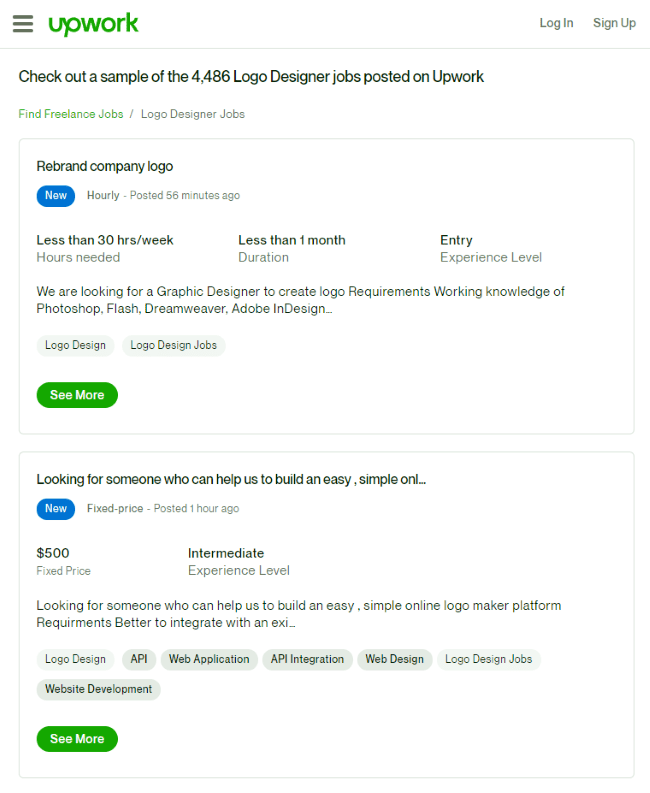
Direct outreach via Apollo.io or LinkedIn yields higher rates eventually. You keep 100% of project fees and control the entire client relationship. But this requires more active effort landing clients and managing contracts yourself.
Part-time availability limits your response time, initially favoring platform gigs over enterprise clients. Enterprise clients expect weekday communication and faster response times. Platform clients often have lower expectations and accept weekend-only communication windows.
Make sure you complete at least 10 platform projects before attempting direct outreach. You need portfolio proof before prospects will trust you.
Start on Fiverr or Upwork to land your first 5 to 10 clients. Build your portfolio and testimonials. Once you’ve proven your delivery capability, transition to direct outreach for higher-paying clients who value your expertise over platform convenience. This hybrid approach maximizes early momentum while building toward better economics.
First 30 Days
Yes, this administrative stuff is boring. I hate it too. I also hate owing the IRS $3,000 in penalties because I skipped quarterly tax payments. Do the boring parts.

Getting started properly prevents legal and financial headaches that derail beginners. This 30-day checklist covers the administrative tasks you can’t skip even though you’d rather start landing clients right away.
Week 1: Choose your business name and register a sole proprietorship or LLC if preferred in your state. Sole proprietorships cost nothing and require minimal paperwork.
LLCs provide liability protection but cost $50 to $500 depending on your state. Most weekend freelancers start as sole proprietors and upgrade to LLCs later.
Week 2: Open a separate business bank account and set up an invoicing system. Use Wave, FreshBooks, or PayPal for beginners.
These platforms handle invoicing, payment processing, and basic bookkeeping in one place. Make sure you never mix personal and business transactions. This separation protects you during tax audits and simplifies tax filing dramatically.
Week 3: Create a basic service contract template using free resources from AIGA or Docracy. Your contract must cover project scope, deliverables, payment terms, revision limits, and timeline. This protects both you and your clients from misunderstandings that kill business relationships.
Week 4: Set up a quarterly estimated tax payment system. Freelancers earning $400 or more must file taxes and should set aside 25 to 30% of gross income for taxes.
Open a separate savings account and transfer your tax percentage the same day you receive payment. The IRS expects quarterly payments on April 15, June 15, September 15, and January 15.
Don’t skip this step. I learned the hard way when I owed $2,400 in April with no savings to cover it. Missing quarterly deadlines triggers penalties on top of taxes owed.
This checklist prevents the common beginner mistake of treating freelancing like hobby income. You’re running a business. Handle the administrative foundation properly so you can focus on delivering great work and landing clients.
Frequently Asked Questions
Will AI Replace Freelancing?
AI eliminates commodity tasks but increases demand for strategic human expertise. Basic freelance services like simple logo design or generic blog posts face pressure from AI tools. But strategic work combining AI capabilities with human judgment commands premium rates. Freelancers using ChatGPT to draft faster then applying their expertise to refine and strategize deliver better results than AI alone. The freelancers thriving in 2025 treat AI as their assistant, not their replacement.
What Next?
We’ve covered the real economics, honest challenges, and practical realities of starting a freelance business as a weekend solopreneur. You now understand when freelancing makes sense, when it doesn’t, and exactly what to expect if you choose this path.
Freelancing won’t build you passive income or free you from active work. But it delivers faster income than content creation while letting you monetize skills you already have.
The right choice depends on your timeline, goals, and whether you need money now or wealth later. Freelancing isn’t necessarily your permanent career path. For many weekend solopreneurs, it’s the bridge funding their transition to passive income business models like courses or content creation.
Have specific questions about your freelancing situation? Drop them in the comments below. I respond to every question with honest guidance based on what works, not what sounds motivational.
Share this post with your friends & followers: